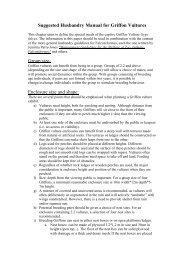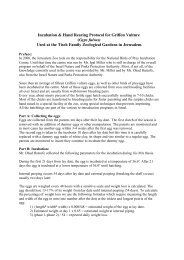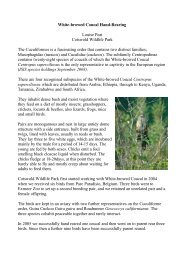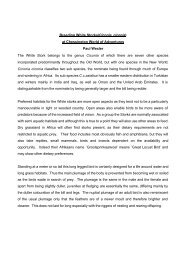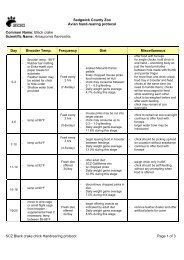Sedgwick County Zoo Avian hand-rearing protocol Common Name ...
Sedgwick County Zoo Avian hand-rearing protocol Common Name ...
Sedgwick County Zoo Avian hand-rearing protocol Common Name ...
You also want an ePaper? Increase the reach of your titles
YUMPU automatically turns print PDFs into web optimized ePapers that Google loves.
<strong>Common</strong> <strong>Name</strong>: Roseate spoonbill<br />
Scientific <strong>Name</strong>: Ajaja ajaia<br />
Brooder<br />
Day<br />
Temp.<br />
0-3 - Brooder temp -<br />
98°F<br />
- Enka-mat over<br />
paper towels,<br />
cloth towels or<br />
rubber bar<br />
matting for<br />
substrate<br />
- chick to remain<br />
in nestbowl in<br />
brooder<br />
4-6 - temp at 95°F<br />
7-10 - temp at 92°F<br />
11-14 - temp at 85-<br />
90°F<br />
15-18 - temp at 85°F<br />
19/20 -<br />
- although active<br />
chicks should be<br />
somewhat<br />
confined; too<br />
much activity may<br />
lead to leg injuries<br />
<strong>Sedgwick</strong> <strong>County</strong> <strong>Zoo</strong><br />
<strong>Avian</strong> <strong>hand</strong>-<strong>rearing</strong> <strong>protocol</strong><br />
Frequency Diet Miscellaneous<br />
Feed every 3 hrs<br />
(5x/day)<br />
7am/10/1pm/4/7<br />
Feed every 3 hrs<br />
(5x/day)<br />
Feed every 3 hrs<br />
(4-5x/day)<br />
7am/10/1pm/4<br />
Feed every 3 hrs<br />
(4x/day)<br />
Feed every 3-4 hrs<br />
(4x/day)<br />
Offer adult diet<br />
3-4x/day<br />
Blended formula of:<br />
- 50g smelt (Osmerus mordax)<br />
- 50g capelin (Mallotus villosus)<br />
- 100g Nebraska® BOP<br />
- 25g Mazuri® flamingo pellets<br />
(crushed)<br />
- ~100ml H2O<br />
- 2 tsp CaCO3<br />
- 2g Vit. E/Thiamin paste<br />
- strain as needed<br />
- fed via syringe fitted with rubber<br />
gavage tube (approx 1-2” long) –<br />
this is to allow birds to feed freely<br />
- not to be used for direct ‘tube<br />
feeding’<br />
- freeze in ice-cube trays and<br />
defrost/heat cubes as needed<br />
(recipe above makes one full ice<br />
cube tray)<br />
- add Pedialyte® to thin as<br />
needed<br />
- chicks may consume up to 10cc<br />
at each feeding<br />
- substitute H2O for pedialyte<br />
- chick may consume up to 30cc<br />
per feeding<br />
- 37% average daily weight gains<br />
- chick may consume up to 50cc<br />
per feeding<br />
- 23% average daily weight gains<br />
- chick may consume up to 100cc<br />
per feeding<br />
- 13% average daily weight gains<br />
- Whole smelt (Osmerus mordax)<br />
- Whole capelin (Mallotus villosus)<br />
- Nebraska® BOP diet –<br />
meatballs w/ Mazuri® flamingo<br />
pellets mixed in (~1:1 ratio)<br />
- items may be moistened with<br />
H20 prior to feeding to increase<br />
hydration as needed<br />
- 10% average daily weight gains<br />
- offer diet in shallow pan and<br />
leave with chicks throughout the<br />
day to encourage self-feeding<br />
- chicks receive first feeding no<br />
sooner than 24hrs post-hatch<br />
- chick to be weighed before and<br />
after each feeding<br />
- chick may remain at zoo or be<br />
taken home as needed<br />
- chicks may be cleaned with warm<br />
water and/or Nolvasan solution<br />
using soft cloth or cotton swabs<br />
when dirty<br />
- a damp sponge should remain in<br />
the brooder to increase humidity<br />
- formula should be offered after<br />
heating; like any infant formula the<br />
temperature for feeding will vary by<br />
individual animal as well as age of<br />
animal; spoonbill chicks will not<br />
readily consume formula if it is too<br />
cold<br />
- chick to remain at zoo overnight<br />
- UV light treatments at least<br />
30min/day from here forward<br />
- add sticks to nestbowl by this point<br />
(if not earlier) to encourage chicks<br />
to grasp and exercise toes/feet/legs<br />
- chicks can be moved to larger<br />
brooder box or wire cage with heat<br />
lamp if temps can be maintained<br />
- chicks should be <strong>hand</strong> fed whole<br />
food items at this point; fish can be<br />
cut in half or thirds as needed<br />
- Vit.E/Thiamin paste or Mazuri<br />
vitamins added to fish as indicated<br />
by amount fed<br />
- Shallow water bowls may be<br />
introduced and chicks encouraged<br />
to drink/dabble<br />
- When possible chicks should be<br />
encouraged to spend time in natural<br />
sunlight<br />
- weigh chicks in AM only to reduce<br />
<strong>hand</strong>ling<br />
SCZ Roseate spoonbill <strong>hand</strong><strong>rearing</strong> <strong>protocol</strong> Page 1 of 3
Adult diet for 0.0.1 Roseate spoonbill at SCZ:<br />
Notes to <strong>hand</strong>-<strong>rearing</strong> <strong>protocol</strong>:<br />
Ingredient form fed<br />
Quantity offered by<br />
Volume<br />
Quantity offered by<br />
weight (g) Frequency offered<br />
<strong>Common</strong> name Roseate spoonbill Capelin (Mallotus villosus) whole 2 52g AM/PM<br />
Scientific name Ajaja ajaja Smelt (Osmerus mordax) whole 5 30g AM/PM<br />
Mazuri® crane pellets whole 1 Tblsp. 5g AM/PM<br />
Mazuri® flamingo pellets* whole 1 Tblsp. 5g AM/PM<br />
Nebraska® Bird of Prey pieces 10 100g AM/PM<br />
* flamingo pellets are mixed into Bird of Prey diet<br />
- The individual referred to as ‘chick#1’ was unable to stand on one of its legs at day 32 of the <strong>rearing</strong><br />
process. It was diagnosed as a slipped tendon. The situation was unable to be resolved and we felt that<br />
quality of life was seriously impacted and the animal was humanely euthanized.<br />
This bird did not show excessive weight gains compared to other chicks. Concerns were initially raised<br />
that the chick had been given too much freedom to move about in a larger pen too early in its <strong>rearing</strong>.<br />
Later chicks were given the same freedom of movement and have not shown any leg issues to date. We<br />
cannot conclusively say why this single bird suffered such an injury.<br />
- Each chick must be managed in the final stage of <strong>hand</strong>-<strong>rearing</strong> individually. Meaning – some chicks will<br />
begin eating quickly on their own – picking up food items readily and consuming them without issue.<br />
Other chicks will need a longer learning curve and should not be left to fend for themselves entirely.<br />
Chicks need to have body weight and food intake monitored closely to ensure they remain healthy.<br />
- When eventually eating on their own completely, <strong>hand</strong>-reared chicks have been introduced to a single<br />
adult spoonbill – usually an older female chosen for its calm temperament. This adult is often housed in<br />
the off-exhibit area with the chicks for a few days to a few weeks prior to introduction into the main<br />
exhibit areas. It has been observed that the chicks will follow their surrogate adult to the feed stations<br />
more quickly than they may have located them on their own. They will also follow the adult readily to<br />
common roosting areas.<br />
SCZ Roseate spoonbill <strong>hand</strong><strong>rearing</strong> <strong>protocol</strong> Page 2 of 3
Products mentioned in <strong>protocol</strong><br />
Mazuri® bird diets:<br />
http://www.mazuri.com/<br />
Pedialyte - Pedialyte is an oral rehydration solution specially formulated to quickly replace lost<br />
fluids and electrolytes.<br />
www.pedialyte.com<br />
Enkamat - Enkamat is the name of a product family of permanent erosion protection mats made of<br />
monofilaments fused together where they cross. All Enkamat products are based on a proven<br />
flexible three-dimensional open structure.<br />
http://www.colbondgeosynthetics.com/cms/generated/pages/products/enkamat/productfamily/default.htm<br />
Mazuri® products:<br />
Thiamin•E is a blend of vitamins specially formulated for animals whose diet consists mainly of<br />
raw fish. The product is guaranteed to provide 100 I.U. d-alpha-tocopheryl acetate (naturalsource<br />
vitamin E) and 50 mg thiamin per ml. Other vitamins include pyridoxine, riboflavin, folic<br />
acid, and biotin in a paste formulation. There is no vitamin A in the product.<br />
http://shop.mazuri.com/thiamine.aspx<br />
Mazuri® Vita-Zu ® Bird Tablet without Vitamin A are formulated to provide supplemental water- and<br />
fat-soluble vitamins to small fish-eating bird species.<br />
http://shop.mazuri.com/mazurivita-zubirdtablets.aspx<br />
Nolvasan ® - (Chlorhexidine acetate) virucidal, bactericidal, fungicidal sanitizing solution useful in<br />
the disinfection of equipment and premises. Normal dilution is one ounce in one gallon of water.<br />
Petiatric brooder –<br />
http://www.petiatric.com/nurseryhospitalbrooders.aspx<br />
Repti-Sun 5.0 Compact Fluorescent UV bulb – ReptiSun® 5.0 by <strong>Zoo</strong> Med® - Provides 5% UVB<br />
Output, 30% UVA Output, full spectrum<br />
http://www.zoomed.com/<br />
Nebraska brand Bird of Prey® diet - Horsemeat based diet for meat-eating birds.<br />
http://www.nebraskabrand.com<br />
SCZ Roseate spoonbill <strong>hand</strong><strong>rearing</strong> <strong>protocol</strong> Page 3 of 3



